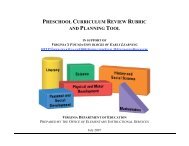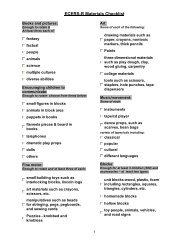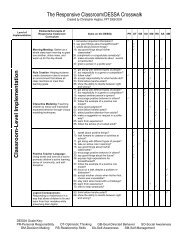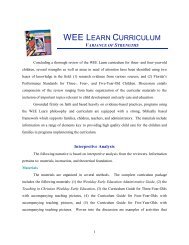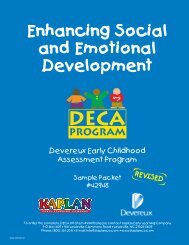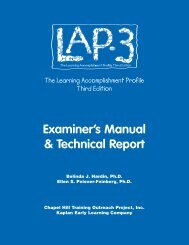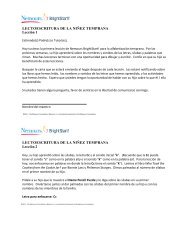Examiner's Manual & Technical Report - Kaplanco.com
Examiner's Manual & Technical Report - Kaplanco.com
Examiner's Manual & Technical Report - Kaplanco.com
- No tags were found...
Create successful ePaper yourself
Turn your PDF publications into a flip-book with our unique Google optimized e-Paper software.
Chapter 2Overview of the LAP-DThis chapter provides an overview of the LAP-D instrument, including the conceptual frameworkand history. Information about the content revisions and assessment materials of the third editionof the LAP-D are presented also.Underlying Principles of The LAP SystemThe LAP System consists of a related set of instructional and assessment materials that offer a<strong>com</strong>prehensive approach to understanding and facilitating the development of young children.The LAP System includes screening and assessment tools to generate a profile of individualdevelopment and provide a means of monitoring ongoing development; curriculum materials thatpromote effective and developmentally appropriate programming; and instructional materialsthat enhance parent involvement and provide guidance for important milestones in youngchildren's lives. This assessment and curriculum model is grounded in early childhood researchthat recognizes young children as active partners in the learning process by:• Emphasizing the value of child choice and responsive teaching• Promoting individualization and respect for each child's unique qualities• Including activities to help children understand and respect diversity (culture, gender,abilities)• Emphasizing the importance of family and <strong>com</strong>munity• Promoting inclusion of children with disabilities.The LAP-D is one <strong>com</strong>ponent of The LAP System, designed to provide a developmentallyappropriate assessment tool that can be used independently or in conjunction with other elementsof The LAP System to create a <strong>com</strong>prehensive educational plan.History of the LAP-DIn 1969, the Chapel Hill Training Outreach Project (CHTOP) was established. The primary focusof the early years of the organization was to develop methods and materials for the effectivedemonstration of high quality services for young children with disabilities and their families.Anne R. Sanford developed the first Learning Ac<strong>com</strong>plishment Profile (LAP) during this time.Items on the LAP were drawn from normative-based measures for children birth to six years old.The original LAP was designed to observe the development of individual children by providingtasks or situations typical of young children’s development that would interest the child andstimulate an observable response as stated by Sanford (1981), “[the LAP addresses] the need fora structured process of assessment which specifies prerequisite skills and facilitates a taskanalysis approach to successful learning.” This basic philosophical thrust was applied to thedevelopment of the LAP-D.7




